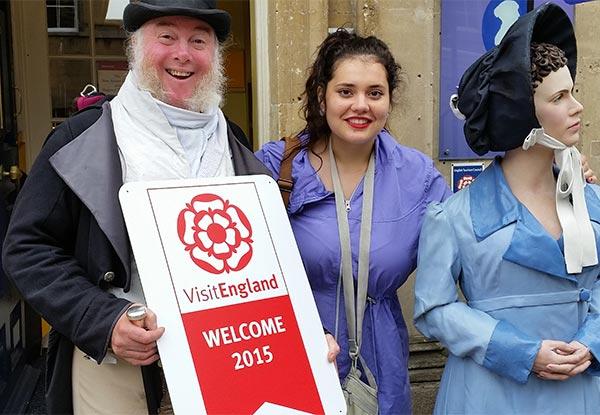What's in a Janeite?
"Well, as pore Macklin said, it’s a very select Society, an’ you’ve got to be a Janeite in your ‘eart, or you won’t have any success."
A few months back, I was involved in an online discussion that veered into the social mores of the early nineteenth century. I posted some information, citing Lord Nelson’s letters and other contemporary accounts, and mentioned that I was a Janeite to explain my interest in the period. A gentleman who answered my post scolded me for calling myself a Janeite. According to him, Janeites were only interested in such meaningless esoterica as tea parties and gowns and the middle names of characters; an obviously thoughtful, well-informed person such as myself should not lower herself to claim the title. I replied that I was indeed, even by his definition, a Janeite. I read the histories. I read the critical works. Yet I still find much of my joy in Jane Austen’s work in the minutiae that is sometimes dismissed by the more learned. The gentleman’s vehemence, however, fascinated me. I’ve called myself a Janeite for years; when the did the term become derogatory?
Many people think that Rudyard Kipling invented the word when he wrote his short story The Janeites, about a group of British soldiers in World War I who found relief from the horrors of war in Jane Austen’s work. However, the first appearance of the word in print (with the slightly different spelling of "Janite") was a preface to an 1894 edition of Pride and Prejudice written by George Edward Bateman Saintsbury, who used the term to refer to Jane’s devoted fans. (Hanaway 28)
Early Janeites such as Saintsbury jealously guarded the image of Jane Austen propagated by Henry Austen and James Edward Austen-Leigh: the demure, proper spinster who lived quietly in the country while penning her "bits of ivory." Austenian scholarship became more critical in the latter part of the twentieth century, when, fueled by a wave of new film adaptations, popular interest in her work exploded. "Every dam’ thing about Jane is remarkable to a pukka Janeite!"
There are those who would have us think that there are two distinct camps of Jane Austen fans. The first group is the hard-core academics, who tend to disdain the second group and the trappings of popular culture associated with it. The second group is what some consider the real "Janeites," who revel in all things Austen. From the novels to the films to the sequels to merchandise such as t-shirts, mugs, stationery, and other items, which they snatch up at Jane Austen Society meetings like a horde of hungry locusts.
Jane Austen is no longer just an author; she is a cultural icon. However, sometimes it seems as though Austenian scholarship must necessarily exclude such innocent enjoyments in order to maintain critical objectivity. This perceived schism in the fandom is reflected in Jane Austen biography and criticism. The early memoirs by family members and devoted fans (which tend to paint Jane Austen as a pious parson’s daughter living in rural English retirement) contrast strongly with some of the more recent productions, some of which portray Jane as a cynical, bitter old maid. So which is the truth? Is the "true" Jane Austen fan devoted to the scholarly pursuits, or queuing up at the Cineplex? Was Jane Austen a witty lady devoted to Church, family, and her bits of ivory, or a man-hating spinster who wielded a poison pen? I humbly suggest that we look to the lady herself for the answers.
Jane distrusted extremes in real life; her writing reflects the reality that truth usually resides somewhere in the middle. No person is purely good, or purely evil; no life choice is completely good or completely bad. We have responsibility to ourselves, and to society as a whole, and life buffets us from many directions as storm winds batter a broken-down sloop. Jane’s message to us is this: Look at a choice from all sides, apply common sense and good morality to the decision-making process, and above all maintain one’s sense of humor. Whether one is an academic or the most casual fan, that’s a difficult message to argue with.
We are fortunate in our fandom to have a sumptuous buffet of pleasures before us. First and most importantly, we have the novels. We also have the wonderful (and not-so-wonderful) film adaptations; we have biographies and histories; we have sequels, retellings, and fan fiction; we have book bags, bumper stickers, and Regency gowns. We can pick and choose from all these delightful manifestations of our chosen obsession, and in true Janeish style, perhaps poke a bit of gentle fun at the more ridiculous. We are all Janeites, under the skin, and in our hearts.
"You take it from me, Brethren, there’s no one to touch Jane when you’re in a tight place. Gawd bless ‘er, whoever she was."
All quotations from "The Janeites" by Rudyard Kipling Works Cited: Hanaway, Lorraine. ‘Janeite’ at 100. Persuasions 16 (1994): 28-29. Kipling, Rudyard. The Janeites, Debits and Credits. Garden City, NY:Doubleday, Page & Company, 1926. 124-147. Margaret C. Sullivan is the webmistress of Tilneys and Trapdoors and is proud to call herself a Janeite.



1 comment
This is fantastic! But, it’s Margaret Sullivan, so of course it is! I absolutely agree that, “We are fortunate in our fandom to have a sumptuous buffet of pleasures before us.” And I love that I can “pick and choose” and “perhaps poke a bit of gentle fun at the more ridiculous.” I am a proud Janeite, and would never consider it a derogatory term . . . what piffle!
Anonymous
Leave a comment
This site is protected by hCaptcha and the hCaptcha Privacy Policy and Terms of Service apply.